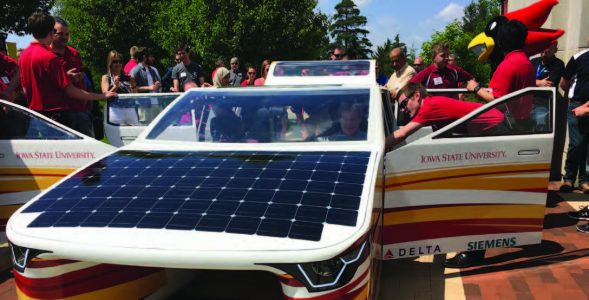
Members of Iowa State University’s PrISUm solar car team see a silver lining in the clouds that dampened their recent trip to Australia for the Bridgestone World Solar Challenge.
Despite rainy weather and a missed checkpoint that knocked them out of the finish, the Iowa State engineering students are taking pride in the fact that they managed to build a practical and highly functional solar-powered SUV—one that, once tweaked, appears destined for future competitions.
“Basically, we went down to Australia and did exactly what we said we were going to do,” said Dylan Neal. “We built a practical car, and it was incredibly reliable. We had zero breakdowns the entire race, and we proved that our car could go 230 miles on a moderately sunny day and 180 miles without sun—all while hauling four passengers.”
Team PrISUm, competing in its first international solar car race throughout Iowa State’s 28-year history of such contests, was knocked out of the finish roughly halfway through the weeklong race last October.
“We made it three days into the competition, but we hit a really bad spell of weather at the end of the day, when our battery pack was dying,” Neal said. “We weren’t able to hit a checkpoint.”
PrISUm, which started out competing among 14 teams
in the World Solar Challenge’s “Cruiser” Class, was instead knocked into the noncompetitive “Adventure” category (along with 10 other teams). However, Iowa State still finished fourth among the 14 teams when judges rated the practicality of the various cars.
This year’s car, named Penumbra, was a departure for PrISUm, Neal said, in that the team deliberately set out to create a vehicle that was as close to a “normal” car as possible.
 The four-passenger vehicle was built with multiple 3D-printed contributions from CIRAS—including a portion of the steerage linkage, the latch on the rear hatch, and a metal emblem on the steering wheel.
The four-passenger vehicle was built with multiple 3D-printed contributions from CIRAS—including a portion of the steerage linkage, the latch on the rear hatch, and a metal emblem on the steering wheel.
“We’re happy CIRAS could contribute,” said Chris Hill, director of CIRAS’ Technology Assistance Program. “We provided parts using both our metal and plastic technologies. The metal is stainless steel. The plastic uses chopped carbon within a nylon filament, and we added carbon fiber strands within those parts. They’re lightweight and extremely tough.”
Neal said Team PrISUm intends to modify Penumbra slightly and compete in the American Solar Challenge this summer. Meanwhile, students will be working on the next iteration of the design—for the team’s return to Australia in 2019. And they will be paying particular attention to the additive manufacturing technology CIRAS can provide.
“Additive technology is the future of vehicles like Penumbra,” Neal said. “It opens the door for lightweight, strong structures never thought possible before, and we are proud
> For more information on 3D printing (additive manufacturing), contact Chris Hill at chhill@iastate.edu or 515-313-8251.
A version of this article was published in the Winter 2018 edition of CIRAS News. To read more of that edition or others, please explore elsewhere on our website.